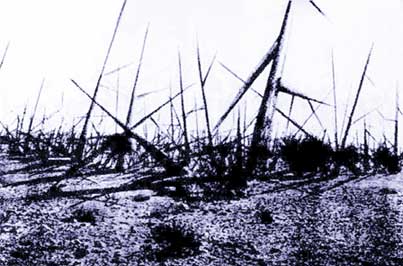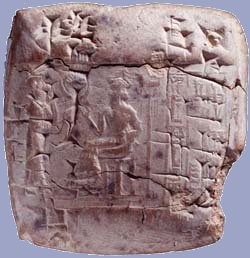| Nuclear Power, The Posterity And Our Stinking Ethics
by Wu Ming 1
(October 2003, translated into English in April 2006)
 "What we excrete comes back to consume us", says Nick Shay in the epilogue of Don DeLillo's novel Underworld. The epilogue is (aptly) titled "Das Kapital", which maybe means that no analysis, no theory, no discourse on production makes no longer any sense if it doesn't tackle the Biggest Problem: our waste, our garbage, the highest mountain on Earth, the mass that crushes future. "What we excrete comes back to consume us", says Nick Shay in the epilogue of Don DeLillo's novel Underworld. The epilogue is (aptly) titled "Das Kapital", which maybe means that no analysis, no theory, no discourse on production makes no longer any sense if it doesn't tackle the Biggest Problem: our waste, our garbage, the highest mountain on Earth, the mass that crushes future.
In the past ten years a certain brand of post-Marxist thought has daydreamt about the "immateriality" of production (and work) in the post-fordist economy. These thinkers entirely built their theories upon a simple stratagem: they hid the dust (i.e. the environmental question) under the rug and fostered "from the left" the superstitios belief in limitless "growth" and a potentially infinite social wealth.
This theoretical current "fell into the potion cauldron as a baby", like Obelix. It was born in Italy as "Operaismo" ("Workerism") during the 1960's economic boom, then grew up in the 1970's, a decade that was marked by such concepts and slogans as "proletarian expropriation" (i.e. glorified shoplifting) or "proletarians have the right to luxury", as well as a strong contempt for any form of austerity. In the 1990's Post-Workerists flattened themselves against the curved walls of the New Economy bubble, and never questioned their founding myths. No serious critique of consumption, no analysis on the limits of growth. Indeed, this thought abhors the very notion of "limit".
In spite of any "immaterialist" delusion, never before in the history of humankind has a society produced so much matter (garbage, trash, waste, rubbish). Never before has a society destroyed so many resources. Never before have humans "consumed" in such an irresponsible way. The "planned obsolescence" of products has put beside traditional garbage also the so-called e-waste: thousands of millions of tons of computers, printers, cd-roms, cell phones, batteries, battery chargers and remote controls, products that become "obsolete" before you can say ehm, and whose repair is considered "uneconomic". They all end up in dumps and then in incinerators, and the dioxin cloud poisons us and the other living species.
When you watch TV and hear the newspeak of "productivity", "policies to boost consumption", and "energy requirements", you ought to think of garbage in order to understand what's behind the jargon.
We don't own the planet: we borrowed it from our posterity. The author of the original Das Kapital wrote: "Even a whole society, a nation, or even all simultaneously existing societies taken together, are not the owners of the globe. They are only its possessors, its usufructuaries, and, like boni patres familias, they must hand it down to succeeding generations in an improved condition."
On the contrary, we will be cursed by the succeeding generations if we aren't able to reverse, restrict consumption, get rid of polluting productions.
The best example of the way we mortgaged the future is nuclear waste, the most dangerous kind of trash. As yet, there is no way to warn our descendants to keep away from it.
In July 2002 the US Senate gave the green light to the storage of 77000 tons of radioactive waste at Yucca Mountain, Nevada. The building of the subterranean repository will cost about sixty million dollars.
Plutonium has a half life of 25000 years. Two-hundred and fifty centuries. The US government was content with ordering its isolation until 12,000 a.C.
The Environmental Protection Agency immediately wondered how to signal the peril to those who come after us, nay, after the great-grandchildren of our great-grandchildren and so on. The EPA called on archeologists, linguists, futurologists, mathematicians, engineers and artists to form a commission and find a universal warning sign that won't decay and will still be understood in ten thousand years time.
 There is an important precedent, that of the Waste Isolation Pilot Plant in Carlsbad, New Mexico. The project was launched ten years ago, and the filling of the repository will be completed in 2033. In order to signal that site, the Department of Energy set two commissions to work. There is an important precedent, that of the Waste Isolation Pilot Plant in Carlsbad, New Mexico. The project was launched ten years ago, and the filling of the repository will be completed in 2033. In order to signal that site, the Department of Energy set two commissions to work.
It is no easy task: it was calculated that, in a time span of maximum 1000 years, any language becomes incomprehensible to the descendants of its speakers. In the present day, with the exception of a few archaeologists and philologists, no Iraqi would understand Accadic, a language spoken in Minor Asia 6000 years ago (it was the language of trade and commerce), and no ordinary person can read cuneiform texts.
The situation doesn't get any better with symbols and pictograms: they all become unintelligible, or dramatically change their meaning. A few millennia ago the swastika symbolized the sun and was considered of good omen. Nowadays it has come to symbolize mass extermination and is forbidden in several countries. And what will be of the trefoil that was designed in 1946 in order to symbolize radioactivity?
Think of monuments: Stonehenge is "only" 3500 years old, and yet we don't know its purpose and meaning. As to the "Keep Out" warnings found in the pyramids of Egypt, we know they had precisely the opposite effect, and drew the curious.
And even if our descendants understood the message we left as a warning of peril, would they consider it still valid after so many centuries?
The two commissions appointed by the DOE suggested two different approaches.
The first one is based on the example of the Rosetta Stone, i.e. a message carved on granite in several languages (the official languages of the United Nations plus Navajo, which is spoken by the Nevada Native Americans), accompanied by symbols and drawings (e.g. a frightened face).
There's a lot of sense in the objections to this proposal: the Rosetta Stone was translated by a specialist, not by ordinary people who bumped into it. Moreover, the granite plaques that were put in the Nevada desert forty years ago as a warning about atomic tests are now invisibile, covered with mesquite bushes.
The second approach consists in making the place as dreadful and appalling as possible. Architect Michael Brill designed a "Landscape of Thorns", i.e. a square mile covered with 50-foot-high, black basalt spikes, jutting out of the sand at all angles. Other artists proposed to arrange the spikes in order to form some pattern.
The main objection is that a spike field could be interpreted as monumental art, and attract the curious instead of keeping them at distance.
Stalemate. It is difficult that the EPA commission finds better solutions. Some artists have already made bizarre (probably ironical) suggestions: Ashok Sukumaran proposed to plant genetically modify cacti all around the repository. These cacti would be cobalt blue and clash with the rest of the landscape. People should infer that there's something wrong with the place. The cacti would be engineered so as to reproduce themselves throughout the centuries. Nevertheless, we don't know if Nevada will suffer drastic climate change. Moreover, that kind of landscape could even be considered "beautiful" instead of repulsive.
It is impossible to signal a peril to the posterity in a safe way, because it's impossible to foresee the future. In the centuries to come any sort of social, environmental and geological disaster might take place. One example is enough. Since 1982, seismologists registered about 600 earthquakes in the Yucca Mountain area, all measuring more than 2.5 on the Richter scale.
Nuclear power is just one of the problems we're handing down to our descendants. Whatever its fans may say, it is an unethical technology, a typical product of capitalism, which forces everything into the confines of the present day and never worries about what will come.
|